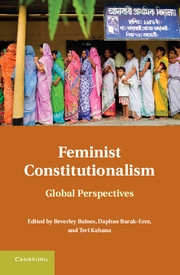Book contents
- Frontmatter
- Contents
- Foreword
- Contributors
- Introduction
- Part I Feminism as a Challenge to Constitutional Theory
- Part II Feminism and Judging
- Part III Feminism, Democracy, and Political Participation
- 9 The Gendered State and Women's Political Leadership
- 10 On Parity, Interdependence, and Women's Democracy
- 11 Women's Involvement in International Constitution-Making
- 12 Between Constitutional Jurisdiction and Women's Rights Organizations
- 13 The Promise of Democratic Constitutionalism
- Part IV The Constitutionalism of Reproductive Rights
- Part V Women's Rights, Multiculturalism, and Diversity
- Part VI Women between Secularism and Religion
- Index
- References
11 - Women's Involvement in International Constitution-Making
Published online by Cambridge University Press: 05 June 2012
- Frontmatter
- Contents
- Foreword
- Contributors
- Introduction
- Part I Feminism as a Challenge to Constitutional Theory
- Part II Feminism and Judging
- Part III Feminism, Democracy, and Political Participation
- 9 The Gendered State and Women's Political Leadership
- 10 On Parity, Interdependence, and Women's Democracy
- 11 Women's Involvement in International Constitution-Making
- 12 Between Constitutional Jurisdiction and Women's Rights Organizations
- 13 The Promise of Democratic Constitutionalism
- Part IV The Constitutionalism of Reproductive Rights
- Part V Women's Rights, Multiculturalism, and Diversity
- Part VI Women between Secularism and Religion
- Index
- References
Summary
In 1776, Abigail Adams pled with her husband to please “remember the ladies” as he left to participate in the U.S. Constitution's all-male drafting process. Centuries later, many women around the world remain uninvolved in their constitutions’ creation and revision, leaving their rights in men's hands.
More than half of current national constitutions were drafted or revised over the last several decades, so it is no surprise that there has been an accompanying explosion of scholarly inquiries into the drafting processes. These publications suggest that constitutions share core elements that transcend differences in cultures, geography, history, and other variables. Taken together, these studies offer a framework for the most successful constitutions in terms of both substance and process. Thus, scholars have been able to offer suggestions for future constitution-drafting processes. Often, however, like the constitution-drafting processes they describe, they omit any discussion of women's involvement. This chapter addresses the significance of that absence and begins to fill the void.
Many questions regarding women’s participation in the creation and revision of constitutions remain unanswered. Which countries have included women? How meaningful were those inclusions? Does the involvement of women substantively change the text of the final document? Is women’s involvement correlated with a constitution’s perceived legitimacy? Although the available resources are limited, the small group of scholars that have discussed women’s participation in individual countries make it possible to begin answering these questions.
- Type
- Chapter
- Information
- Feminist ConstitutionalismGlobal Perspectives, pp. 204 - 222Publisher: Cambridge University PressPrint publication year: 2012
References
- 1
- Cited by

